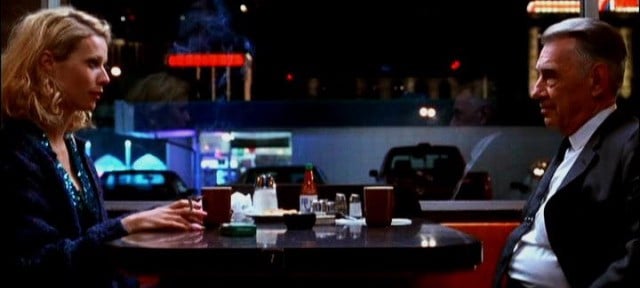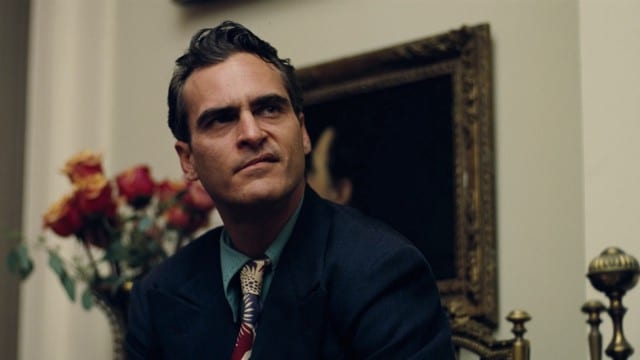In 2002, a shift occurred in the structure and thematic concerns that inform the style, characters, and narratives of Paul Thomas Anderson’s films. Anderson’s fourth film, Punch-Drunk Love, clocking in at only ninety-four minutes (exactly half the length of his previous Magnolia) seemed a necessary exercise in modesty for the ambitious auteur, a means of proving himself capable of telling a story that focuses on the lives of less than a half dozen characters in a running time that is far from daunting.
This film seemed, at the time, to be a momentary departure. Certainly Anderson, after working Adam Sandler toward what will certainly remain the greatest performance of his career, would return to constructing complex labyrinths depicting the intertwining lives of many memorable characters. After all, Punch-Drunk Love only featured two members of Anderson’s signature ensemble (Philip Seymour Hoffman and Luis Guzman). But as There Will Be Blood indicated, Anderson intended no such return to Altmanesque mosaics, opting instead to dive even further into the impenetrable psychologies of enigmatic leading men, an interest that has almost inevitably led Anderson’s trajectory to The Master.
Three The Hard Way

Anderson’s first three films – Hard Eight, Boogie Nights, and Magnolia – meticulously depicted the inner and outer-workings of subcultures and social tribes whose actions motivate and determine the happiness and success of one another. There are ultimately no questions about what motivates Sydney to befriend John, what moves Dirk Diggler to become a porn star or adopt Amber Waves as a replacement mother, or what inspires “Quiz Kid” Donnie Smith to get braces and rob a safe. Ambiguous character motivation was very much not Anderson’s forte in this regard – all questions are ostensibly answered in the end. Anderson’s 90s work displayed a fascination with the particular interactions amongst clearly defined humans within a group, and how circumstance and intent motivated the next chapter in the lives of each member.
By situating his characters within clearly delimited social groups in his first three films, even as the interactions between characters proved more pretzel-shaped than anything else, Anderson’s narratives exhibited a clear insulated logic of cause/effect and action/reaction. Yes, frogs fall from the sky and Marky Mark collaborates in a shady drug deal involving Alfred Molina, firecrackers, and Night Ranger, but there’s no denying what brought these characters to this precise moment.
Punch-Drunk Love, however, inaugurated a shift away from interpersonal interdetermination and toward excavating of the mysteries of how the individual male eventually becomes who he is, but without providing any clear answers.
What’s most striking about Anderson’s latter three films is that they forgo any easy – or even discernable – path towards their characters’ determination. In the months leading up to the release of There Will Be Blood, for example, critics predicted a Citizen Kane-like grand American gain-the-world/lose-your-soul arc, but Daniel Plainview never displayed a soul to potentially lose in the first place. Moments of the film, like his violent baptism at the hands of Paul Sunday, suggest regret for being an instrument in his son’s deafness and subsequent departure, but Plainview’s conscience-liberated psyche remains impenetrable.
Besides his insatiable greed, his motives remain elusive and his actions often seem spontaneous. Any biographical information he shares is unreliable and he seems intent on destroying any remnants of his past, as evidenced by the murder of Henry. Daniel Plainview is, in short, an enigma of a similar variety to Barry Egan, Freddie Quell, and Lancaster Dodd.
Portrait of the Artist as an Insecure Man
Not all these characters are violent, brooding capitalists, of course, but they are all connected in their varied antisocial sensibilities and the lack of clear explanation or change in their behavior, even when supposed causes are noted and clear consequences take place. Sure, Barry Egan seems to be a repressed, emotionally insecure mess in part as a result of the decades of berating he suffers by his flock of sisters, but Sandler’s performance suggests something deeper and less definite: that his sisters didn’t cause his insecurities but instead exploited deep troubles that already existed. When Egan falls in love with Lena, this doesn’t so much motivate a change his behavior as it redirects his violent-to-sweet tendencies into a more productive place. Egan hasn’t changed who he is; he’s found somebody who not only tolerates his enigmatic self, but loves him.
What’s fascinating about The Master in the context of Anderson’s larger body of work is that it seems culminate the pair of defining tendencies that dominated the first two phases of his career. Like Anderson’s first three films, The Master is about a particular and unique group of people who have come together based on shared interests, in this case the communal search for meaning, purpose, and enlightenment through Dodd’s Scientology-reminiscent “The Cause.” At the same time, The Master is really, at its center (and like Anderson’s two previous films), about not one but two enigmatic men whose respective pasts can only fleetingly and partially explain their complex actions and current conditions.
The time period depicted in The Master is the perfect context for Anderson to explore these two facets together. After WWII, white middle-class America saw itself divided into ever-more discrete factions. Families moved to the suburbs and experienced the enclosed space of the home that was occasionally opened to a select set of friends and family at the expense of the more diverse and interactive landscape of the city. A youth culture emerged in the form of rock n’ roll and drag racing. Consumers were catered to by advertising firms through advanced research that divided the populace into ever-more specific categories for targeting.
At the same time that the postwar white middle-class American sought meaning through a delimited group, they also, largely for the first time and enabled by the privilege of leisure time that came with postwar prosperity, looked deep into the self for meaning with the belated popularization of psychoanalysis in America. Thus, The Master is, without contradiction, about the search for meaning through the group alongside the interrogation of the self.
These Bodies That We Hold

This is also why Quell and Dodd can never be fully “explained” in any narratively convenient terms. Like Barry Egan, there are clear moments of Quell’s past that can potentially clarify his condition in part, but none prove adequate (hardly a clear case of PTSD: Quell seems just as worn, tortured, and old in the years before going to war as after). Quell’s pure id, while enigmatic, is laid bare, but Dodd’s performance of cultivation and authority is rendered sturdy through the construction of deep shields to his past. Dodd, while constantly on display for all to see, is perhaps Anderson’s most mysterious character yet. How does such a man acquire such a following? We elide the histories that, by pure chance, bring us together, but that’s why some human interconnections are meaningful beyond any clear explication that a history of determination would provide.
If the question you have going into The Master is “Why would someone join a fringe religious organization (i.e., a cult),” then the film will surely disappoint. To provide a conclusive answer to these questions would be to assert that postwar cultural segmentation, rapid change, domestic discontent, social trauma, and pressures of conformity in the face of unprecedented prosperity can be reduced to something as easily explicable as a biography that chronicles clear motives and cause/effect relationships. It’s simply no longer enough for Anderson to state that a person is determined by their culture, their environment, or their interaction with others.
Conventional narrative cinema does not often leave room for the sporadic decisions and seemingly unmotivated actions that social beings witness regularly. But the recent trajectory in Anderson’s cinema does – maddeningly and beautifully so.
